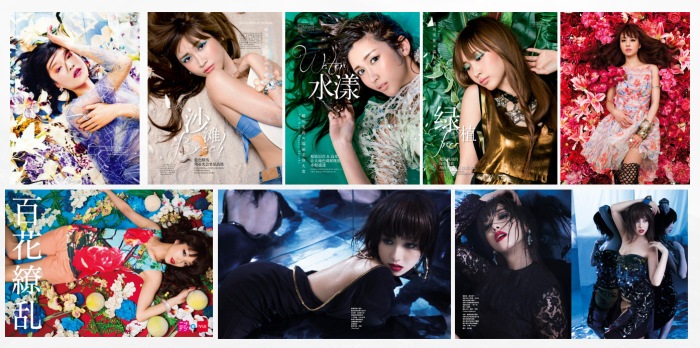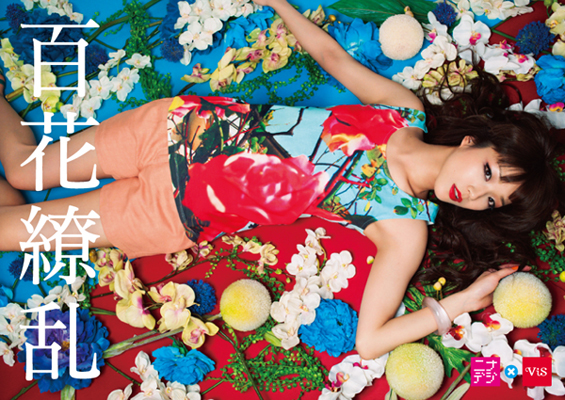Ninagawa Mika
As one of Japan’s most successful commercial photographers, Mika Ninagawa has dabbled in portraiture, fashion, advertising, and everything in between, known for her use of vibrant, brightly coloured photographs of flowers, goldfish, and landscapes with dynamic angles. Her combination of traditional Japanese elements (such as kimonos) and futuristic palettes makes her work immediately stand out.
She has enjoyed significant commercial success in fashion and advertising. She made her debut as a full-length film director in 2007 with Sakuran. In September 2010, her music video for the AKB48 song “Heavy Rotation” was released. She directed the live-action film adaptation of the manga Helter Skelter in 2012.

With so many details to consider about, preparing for my oriental shoot has been a daunting experience, even when researching for visual references was quite a challenge because there weren’t many similar work examples out there. Until I found the works of photographer Ninagawa Mika, there had not been examples of photographer’s works which closely resembles what I am doing. Ninagawa Mika uses vibrant colours in her fashion shoot. That fits the bill for my style. Some of her works include models with body posture in a reclining position. That is also exactly what I have been looking for. But this was one day before my actual shot.
How do I see if the model in reference is in a reclining position rather than standing against a wall of flowers? Easy. Usually, there are three clues to tell:
1)The flow of the model’s hair against gravity
2) the flow of the dress against gravity.
3) the neck muscles of the model.
But sometimes a masterful photographer and a good retoucher would have found ways to hide these details as much as possible. Hence the images below were picked to analyse how Ninagawa Mika manages those shots successfully.

In this image meant for Vogue Taiwan magazine which features Taiwanese pop singer, Jolin Tsai in a floral dress. The colour of her floral dress matches the bed of flowers in the background well. Her feminine body posture seemingly in a reclining position, as clues of her hair and neck posture, suggest. However, her dress does not flow naturally towards gravity, and the white spaces underneath those flowers are visible. Hence these clues suggest she is in a standing position and her hair had been masterfully manipulated.
The lighting appears to be frontal and diffused. Clues could be found on the reflections on the shiny bangles on her arms. and the camera angle appears to be slightly below the model’s eye level.
Unless there are visual references of behind the scenes shoot, it is quite difficult to distinguish if the model is in a standing or reclining position. But precisely because it is difficult to tell, I consider this shot to be well executed. I think its contributing factors are the models’ expression, her body postures and the flow of her hair. The extra accessories on her arms add more feminity to this image.
Update: I found the behind the scenes video footage from this particular shoot.

This image was shot for Rayli Chinese Magazine featuring Saeko. In this image, the model is definitely in a reclining position as her hair seeps into the water. However, judging by the close-up of this image, it is difficult to tell how deep the water is. The model does not wear many accessories, possibly because there are sufficient interesting details on her clothes. The model doesn’t wear fanciful makeups. Generally, it is quite a clean image.
In this image, I looked at the expression, the hand posture, and particularly the camera angle, which is quite different from the ones I planned for my shoot. How the camera angle frames the model compositionally is an interesting analyse. It works here because this consideration is meant for the editorial design for the page. However if it were me attempting such angles in my other works, it somehow looks weird. I am not sure why.

This image was shot for a Rayli Chinese Magazine, featuring Saeko. The settings in this image are quite similar to my shoot. In this reference, I looked particularly at how the model’s hair is placed compositionally. It doesn’t look awkward in the close-up camera angle. There are minimal makeup and accessories complimenting the sand detail. I like the detail of the bits of sand stuck onto the model’s arms.

Also in other works, Ninagawa Mika seems to have worked with mirrors and reflections for her other fashion shoots. quite interesting to see how she uses them. this is quite similar to what I was experimenting with my cube mirrors. But considering she is an art director, and a team behind to support her vision, I don’t have the means to have such large mirrors for my own self-funded photography projects. I could only keep this reference in view…
Ninagawa loves arranging her works into books. “I like that a book has a tangible form and that people can own it,” she says one interview. “I enjoy the process of making books, even though it can be a struggle… When I make my books, I sometimes plan it in a logical manner, but in the end, what matters are my own feelings. The process starts with a gorgeous sense of euphoria, but it gets mellow towards the end, and finally, a crisp finale!” That “process” from euphoria to mellowness to crispness sounds much like a wine tasting, and Ninagawa’s photography intoxicates much like a wine, but a fruity, complex vintage that offers surprising complexity after the initial impression.



